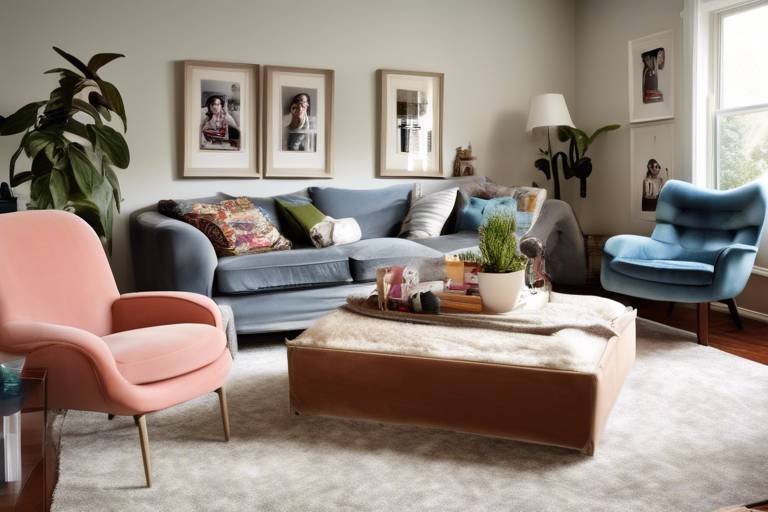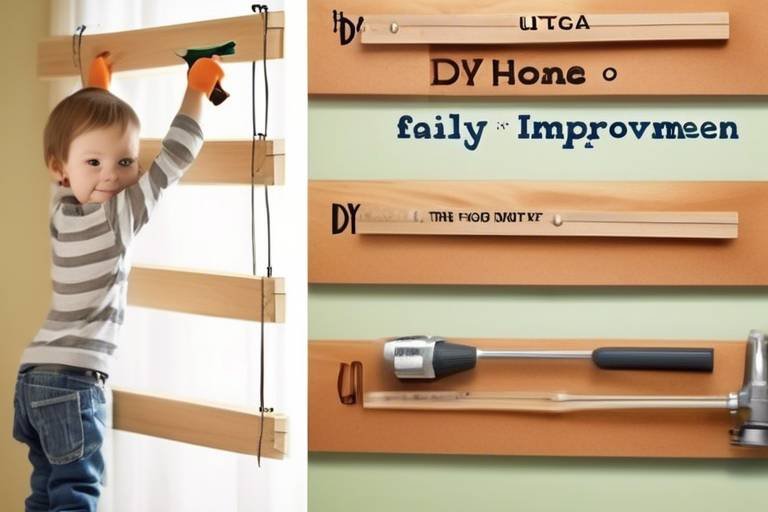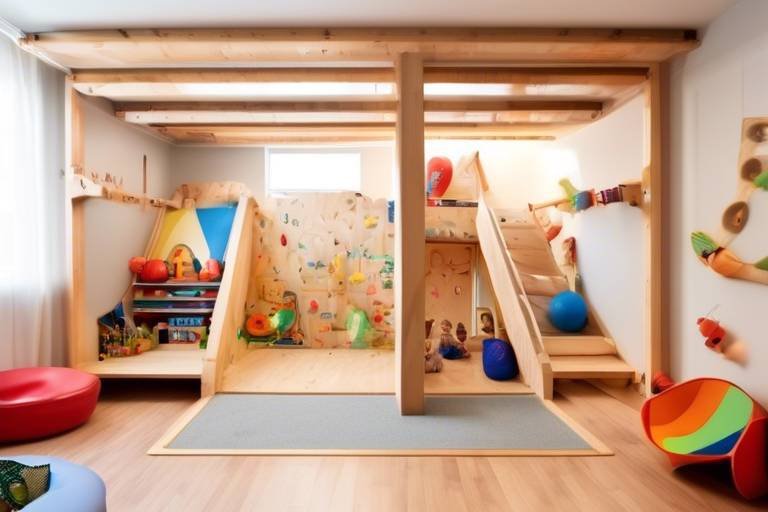Breathing New Life into Your Family Living Room
Are you tired of looking at the same old living room that feels more like a museum than a cozy family space? It’s time to breathe new life into that room where you spend countless hours with your loved ones. Think of your living room as the heart of your home—a place where laughter echoes, stories are shared, and memories are made. Revitalizing this space doesn't have to be a daunting task; in fact, it can be a fun adventure! With a sprinkle of creativity and a dash of practicality, you can transform your living room into a vibrant haven that reflects your family's personality and meets everyone’s needs.
In this article, we’ll explore innovative ideas and practical tips to rejuvenate your family living room. From assessing your current space to choosing the perfect color palette, we’ll guide you through every step of the process. We’ll also delve into creating functional zones, incorporating smart furniture solutions, and balancing comfort with style. By the end, you’ll be armed with all the knowledge you need to make your living room not just a room, but a cherished gathering place for your family.
So, are you ready to roll up your sleeves and get started? Let’s dive into the first step of your living room makeover journey!
Before diving headfirst into a complete redesign, it’s essential to take a step back and evaluate your current living room layout. This is like taking your car for a check-up before a long road trip; you want to ensure everything is running smoothly! Start by asking yourself a few key questions:
- What do I love about my current space?
- What feels cluttered or cramped?
- Are there any areas that are underutilized?
By identifying the strengths and weaknesses of your living room, you can pinpoint areas for improvement. Maybe you have a beautiful window that’s hidden behind heavy drapes, or perhaps your furniture layout makes it difficult to navigate the room. Whatever the case may be, taking the time to assess your space will set the stage for a successful transformation.
Now that you’ve assessed your space, it’s time to think about color! Choosing the right colors can dramatically change the atmosphere of your living room. A cohesive color scheme not only enhances the aesthetic appeal but also reflects your family’s personality. Imagine walking into a room painted in soothing blues and greens that instantly calms your mind, or a vibrant yellow that fills the space with warmth and joy.
Colors have a profound impact on our emotions and behaviors. This is where color psychology comes into play. For instance, did you know that:
- Blue promotes tranquility and peace?
- Red stimulates energy and passion?
- Green encourages balance and harmony?
By choosing colors that resonate with your family’s vibe, you can create a living room that not only looks good but feels good too!
When selecting a color palette, consider the difference between warm and cool tones. Warm colors, such as reds, oranges, and yellows, can make a space feel cozy and inviting, while cool colors, like blues and greens, can create a serene and spacious feel. Think about how you want your living room to feel. Do you want it to be a lively gathering spot or a calm retreat? Your choice of tones will significantly affect the overall atmosphere.
Don’t forget about accent colors and patterns! These elements can add depth and interest to your living room design. Consider using throw pillows, rugs, and artwork to introduce pops of color without overwhelming the space. Imagine a neutral sofa adorned with bright, patterned cushions that catch the eye and spark conversation!
One of the best ways to enhance your living room is by creating functional zones. This means dividing your space into areas that serve specific purposes, such as a reading nook, a play area for kids, or a cozy spot for family movie nights. By doing this, you ensure that each zone flows harmoniously into the next, allowing for both functionality and comfort.
Smart furniture choices can maximize space and enhance usability. Think of furniture as the building blocks of your living room. Choosing multifunctional pieces can make a world of difference in how your family interacts with the space. For example, a coffee table that doubles as a storage unit can help keep clutter at bay while providing a stylish focal point.
Explore innovative space-saving furniture solutions that can help you maintain an organized and clutter-free living room. Consider wall-mounted shelves or ottomans with hidden storage. These options not only save space but also add a modern touch to your decor.
Balancing comfort and style is crucial in furniture selection. You want pieces that are not only aesthetically pleasing but also comfortable for everyday use. Think about your family’s lifestyle—do you have kids and pets? Opt for durable fabrics that can withstand wear and tear while still looking fabulous.
Q: How can I make my small living room feel larger?
A: Use light colors, mirrors, and multifunctional furniture to create an illusion of space.
Q: What are some budget-friendly ways to refresh my living room?
A: Consider DIY projects, repurposing existing furniture, and adding new accessories like cushions and artwork.
Q: How often should I update my living room decor?
A: It depends on personal preference, but a seasonal refresh or every couple of years can keep things feeling fresh.

Assessing Your Current Space
Before diving headfirst into a renovation or redecoration project, it's crucial to take a step back and assess your current living room space. Think of this as your starting line; understanding what you have will help you determine what you need. Grab a notepad and take a good look around. What do you love about your living room? What feels off? Maybe it’s the outdated furniture, or perhaps the layout doesn’t quite fit your family’s lifestyle. Start by jotting down your observations, as this will serve as your roadmap for transformation.
One effective way to evaluate your space is to consider its strengths and weaknesses. For instance, does your living room get ample natural light? If so, that’s a strength to build upon! But if it feels cramped or cluttered, that’s a weakness that needs addressing. You might even want to create a simple table to weigh these aspects:
| Strengths | Weaknesses |
|---|---|
| Ample natural light | Cramped layout |
| Cozy atmosphere | Outdated furniture |
| Good flow to adjoining rooms | Lack of storage |
Next, consider the functionality of your living room. Is it serving the needs of your family? For example, if your family enjoys movie nights, is your seating arrangement conducive to that? If you often host friends and family, do you have enough seating? Think about how you use the space daily and what changes could enhance your experience. You might want to ask yourself:
- How many people typically use the living room?
- What activities take place here—watching TV, reading, playing games?
- Are there any obstacles that hinder movement or flow?
Lastly, take a moment to evaluate your decor and accessories. Do they reflect your family's personality and style? A living room is more than just a collection of furniture; it’s a reflection of who you are. If your decor feels mismatched or uninspired, it might be time for a refresh. Consider what pieces truly resonate with you and which ones can be replaced or updated.
By thoroughly assessing your current space, you’ll gain valuable insights that will guide your decisions moving forward. Remember, this is about creating a living room that not only looks good but also feels good—a space where your family can gather, relax, and make lasting memories.

Choosing a Color Palette
When it comes to revitalizing your family living room, one of the most impactful changes you can make is selecting the right color palette. The colors you choose will not only define the aesthetic appeal of the space but also influence the overall mood and atmosphere. So, how do you go about picking a color scheme that truly reflects your family’s personality and enhances the living room experience? Let’s dive in!
First off, consider the emotional impact of colors. Different hues can evoke various feelings and responses. For instance, warm colors like reds and oranges can create a vibrant and energetic atmosphere, perfect for family gatherings and lively conversations. On the other hand, cool colors such as blues and greens promote a sense of calm and relaxation, ideal for winding down after a long day. It’s all about finding the right balance that suits your family’s lifestyle.
Color psychology is a fascinating field that examines how colors affect our emotions and behaviors. When selecting a palette for your living room, think about the feelings you want to encourage. For example:
- Red: Passion and energy
- Blue: Calmness and serenity
- Yellow: Happiness and optimism
- Green: Balance and harmony
By understanding these associations, you can make informed choices that will help create a living room where everyone feels comfortable and happy.
Now that you have a grasp on color psychology, let’s talk about warm and cool tones. Warm tones, such as reds, oranges, and yellows, can make a space feel cozy and inviting. They are perfect for creating a lively atmosphere where family and friends can gather. In contrast, cool tones like blues, greens, and purples tend to have a more soothing effect, making them great for promoting relaxation. Depending on your family’s needs, you might want to incorporate a mix of both to create a dynamic yet harmonious space.
Once you’ve settled on a primary color scheme, it’s time to think about accent colors and patterns. These elements can add depth and visual interest to your living room without overwhelming it. For instance, if you choose a neutral base color for your walls, consider adding vibrant accent pillows, artwork, or decorative throws in complementary hues. Patterns, such as stripes or florals, can be introduced through rugs or curtains to create a lively contrast. Just remember, moderation is key—too many bold patterns can create chaos instead of harmony!
As you explore your options, consider creating a mood board to visualize how different colors and patterns will work together. This can be as simple as a digital collage or a physical board where you pin fabric swatches, paint samples, and images that inspire you. By seeing everything together, you can make more confident decisions about your living room’s color palette.
In conclusion, choosing the right color palette for your family living room is about more than just aesthetics; it’s about creating a space that reflects your family’s values and enhances your everyday life. Take your time, do your research, and don’t be afraid to experiment. After all, your living room should be a place where memories are made, laughter is shared, and everyone feels at home.

Understanding Color Psychology
When it comes to designing your family living room, color psychology plays a crucial role in shaping the mood and ambiance of the space. Have you ever walked into a room and instantly felt either energized or relaxed? That’s the power of color at work! Each hue has its own unique vibe and can evoke different emotions, making it essential to choose wisely when revitalizing your living area.
For instance, warm colors like red, orange, and yellow tend to create a sense of warmth and comfort. They can stimulate conversation and encourage social interaction, which is perfect for family gatherings. On the flip side, cool colors such as blue, green, and purple are known for their calming effects. They can help create a serene environment, ideal for relaxation after a long day. By understanding these effects, you can tailor your living room to suit your family's needs and lifestyle.
Here’s a quick breakdown of how different colors can influence your living space:
| Color | Emotion/Effect |
|---|---|
| Red | Energy, Passion, Excitement |
| Blue | Calmness, Trust, Serenity |
| Green | Balance, Harmony, Refreshment |
| Yellow | Happiness, Optimism, Creativity |
| Purple | Luxury, Mystery, Spirituality |
By incorporating these colors thoughtfully, you can create a living room that not only looks good but also feels good. Imagine a space where the vibrant yellows spark joy and creativity, while soothing blues provide a tranquil retreat for family movie nights. The key is to strike a balance between these colors to reflect your family's personality and lifestyle.
Additionally, consider the impact of accent colors. These are the shades you use to highlight certain areas or elements in your living room. For example, a bold red throw pillow can create a focal point against a neutral sofa, adding interest without overwhelming the space. The right combination of primary and accent colors can transform your living room into a harmonious and inviting atmosphere.
Ultimately, understanding color psychology is about more than just aesthetics; it’s about creating a space that resonates with your family’s emotions and activities. So, as you embark on this journey to breathe new life into your living room, remember to choose colors that not only appeal to the eye but also nurture the heart.
- What is color psychology? Color psychology is the study of how colors affect human behavior and emotions.
- How can I choose the right color for my living room? Consider the mood you want to create and how different colors impact emotions. Use a mix of warm and cool tones to balance energy and relaxation.
- Can I use bold colors in a small living room? Yes! Bold colors can add personality and vibrancy. Use them as accents to avoid overwhelming the space.
- What are some good accent colors? Consider using colors like teal, coral, or mustard to complement neutral tones in your living room.

Warm vs. Cool Tones
When it comes to decorating your living room, understanding the difference between warm and cool tones can have a significant impact on the overall feel of the space. Imagine walking into a room that feels like a warm hug—this is the essence of warm tones. Colors like reds, oranges, and yellows evoke feelings of comfort, energy, and happiness. They can make a space feel more inviting and cozy, which is perfect for family gatherings or a relaxing evening at home.
On the flip side, cool tones such as blues, greens, and purples can bring a sense of calm and tranquility to your living room. They often remind us of nature—think of a serene lake or a clear blue sky. Using cool tones can create a refreshing atmosphere, making it an ideal choice for those who prefer a peaceful retreat after a long day. However, it's essential to strike the right balance. Too much of either can lead to a space that feels either overly stimulating or too cold and uninviting.
To help you visualize the impact of these tones, consider the following table that outlines how each can affect the ambiance of your living room:
| Color Tone | Emotional Impact | Best Uses |
|---|---|---|
| Warm Tones | Inviting, Energetic, Cozy | Family gatherings, Play areas |
| Cool Tones | Calm, Refreshing, Relaxing | Reading corners, Meditation spaces |
When choosing between warm and cool tones, think about the activities that will take place in your living room. If you envision lively conversations and laughter, warm tones might be the way to go. However, if your family enjoys quiet evenings with a good book or a movie, incorporating cool tones could enhance that experience. The key is to find a balance that reflects your family's personality while creating an environment that feels just right.
Additionally, you can mix both warm and cool tones to achieve a dynamic look. For example, pairing a warm beige sofa with cool blue accent pillows can create visual interest while maintaining a cohesive feel. It's all about layering colors and textures to create a harmonious space that feels both inviting and stylish.
So, as you embark on your living room transformation, remember that the colors you choose will not only define the aesthetic but also influence the mood of your home. Whether you lean towards warm or cool tones, make sure it resonates with your family's vibe and lifestyle.
- What are some examples of warm and cool tones?
Warm tones include reds, oranges, and yellows, while cool tones encompass blues, greens, and purples. - Can I mix warm and cool tones?
Absolutely! Mixing both can create a balanced and visually interesting space. Just ensure they complement each other. - How do colors affect mood?
Colors can evoke different emotions; warm tones tend to energize and invite, while cool tones promote calmness and relaxation.

Accent Colors and Patterns
When it comes to decorating your family living room, can be the secret ingredients that elevate your space from ordinary to extraordinary. Think of your living room as a canvas; the main colors are the background, while the accents are the vibrant brush strokes that add depth and personality. Choosing the right accent colors can create a harmonious flow and make your room feel more inviting. But how do you decide which colors and patterns to incorporate? It’s all about balance and proportion!
First, consider the main color scheme you’ve chosen for your living room. If you’ve opted for neutral tones like beige or gray, introducing bold accent colors such as teal, mustard yellow, or even a vibrant coral can create a striking contrast that breathes life into the space. On the other hand, if your main palette consists of rich jewel tones, you might want to use softer accent colors like blush pink or light gray to avoid overwhelming the senses. A well-thought-out color scheme can evoke feelings of warmth and comfort, making your living room a cozy retreat for family gatherings.
Patterns also play a vital role in adding visual interest to your living room. Whether you choose geometric designs, floral prints, or abstract motifs, the key is to use them strategically. For instance, if you have a solid-colored sofa, consider adding patterned throw pillows or a textured blanket to create layers. A patterned area rug can also serve as a focal point, anchoring the room and drawing the eye. The interplay of patterns can make your living space feel dynamic and engaging. Just remember, too many competing patterns can create chaos, so it's crucial to maintain a sense of cohesion.
To make the selection process easier, here’s a quick guide on how to effectively combine accent colors and patterns:
| Accent Color | Best Patterns | Suggested Combinations |
|---|---|---|
| Teal | Geometric | Teal pillows with geometric patterns on a neutral sofa |
| Mustard Yellow | Floral | Mustard yellow curtains with floral print cushions |
| Coral | Stripes | Coral accent chair with striped throw blanket |
Incorporating these elements can make a significant difference in how your living room feels and functions. Don’t shy away from experimenting with different combinations to see what resonates with your family’s style. After all, your living room is a reflection of who you are, so let your personality shine through! And remember, the goal is to create a space that feels both stylish and comfortable, inviting everyone to kick back and enjoy.
- What are accent colors? Accent colors are hues that contrast with the main color scheme to add visual interest and depth to a space.
- How many accent colors should I use? It's generally best to limit yourself to two or three accent colors to maintain a cohesive look.
- Can I mix patterns in my living room? Yes! Just ensure that the patterns complement each other and maintain a balance with solid colors.

Creating Functional Zones
When it comes to designing your family living room, the concept of functional zones is a game changer. Imagine your living room as a canvas where each area serves a distinct purpose, yet flows seamlessly into the next. This isn’t just about aesthetics; it’s about creating a space that adapts to your family's lifestyle. Think of it like organizing a party: you wouldn’t want all your guests crammed into one corner, right? You’d create areas for mingling, eating, and relaxing. Similarly, your living room can be divided into zones that cater to different activities, enhancing both functionality and comfort.
To start, consider the activities your family enjoys most. Do you love movie nights, board games, or perhaps a cozy reading nook? By identifying these key activities, you can designate specific areas for each. For example, you might have a media zone with a comfy couch and a large TV, a reading corner with a plush armchair and good lighting, and a play area for kids with soft rugs and storage for toys. This not only keeps the space organized but also encourages everyone to use the living room more effectively.
Next, think about furniture arrangement. Positioning is crucial in creating functional zones. For instance, if you have a sectional sofa, place it to define the media zone while leaving enough space for foot traffic. Use area rugs to visually separate different zones; this can help to demarcate spaces without the need for physical barriers. A rug under the coffee table can create a cozy conversation nook, while another in the play area can signal a safe space for kids to enjoy their activities.
Don’t forget about the importance of lighting in each zone. Different activities require different lighting levels. A soft, warm glow is perfect for the reading corner, while brighter, focused lighting works well in the play area. Consider using a combination of floor lamps, table lamps, and overhead lighting to create a versatile atmosphere that can be adjusted based on the time of day or activity. This flexibility not only enhances the aesthetic appeal but also ensures that each zone is practical and inviting.
Lastly, keep in mind that storage solutions play a vital role in maintaining the functionality of your living room. Clutter can quickly turn a beautifully designed space into a chaotic mess. Incorporate stylish storage options that blend with your decor, such as decorative baskets, built-in shelving, or multi-functional furniture like ottomans with hidden storage. This way, you can keep each zone tidy and ready for use, making your living room a welcoming space for family gatherings and relaxation.
In summary, creating functional zones in your living room is all about understanding how your family interacts with the space. By thoughtfully designating areas for specific activities, arranging furniture effectively, utilizing appropriate lighting, and incorporating clever storage solutions, you can transform your living room into a vibrant and functional hub that everyone will love. So, are you ready to breathe new life into your family living room?
- What are functional zones? Functional zones are designated areas within a space that serve specific purposes, such as a reading nook, media zone, or play area.
- How do I create functional zones in my living room? Start by identifying the activities your family enjoys, arrange furniture to define these areas, use rugs to separate zones, and ensure each area has appropriate lighting.
- Can I have more than three functional zones? Absolutely! The number of zones depends on the size of your living room and your family's needs. Just ensure that each zone flows well into the next.
- What if my living room is small? In smaller spaces, focus on multifunctional furniture and clever storage solutions to maximize usability without overcrowding the area.

Incorporating Smart Furniture Solutions
When it comes to revitalizing your family living room, one of the most impactful changes you can make is to incorporate smart furniture solutions. These are not just any pieces of furniture; they are multifunctional, space-saving, and designed to adapt to your family’s diverse needs. Imagine a coffee table that transforms into a dining table or a sofa that converts into a bed for those unexpected sleepovers. The beauty of smart furniture lies in its ability to maximize your space while enhancing usability, making your living room a more inviting and functional area.
One of the first steps in selecting smart furniture is to assess your current layout and identify the main activities that take place in your living room. Are you often hosting game nights? Do you need a cozy reading nook? Or perhaps you require extra seating for family gatherings? By understanding your family's lifestyle, you can choose pieces that not only fit well but also serve multiple purposes. For instance, consider a stylish ottoman that doubles as storage for blankets or games, keeping your living room tidy and organized.
Let’s dive deeper into some innovative space-saving options that can truly transform your living room:
- Modular Sofas: These versatile pieces can be rearranged to fit different occasions, whether you need a cozy setup for movie night or a spacious arrangement for entertaining guests.
- Expandable Dining Tables: Perfect for those surprise dinner parties, these tables can be extended to accommodate more people and then reverted back to a smaller size when not in use.
- Wall-Mounted Desks: If you work from home or need a study area for the kids, a wall-mounted desk can be folded away when not in use, freeing up floor space.
Comfort is another crucial factor to consider when selecting smart furniture. You want pieces that not only look good but also feel great for everyday use. Think about fabrics, cushioning, and ergonomics. A chic chair that feels like a cloud can make all the difference when you’re curling up with a good book or catching up with family. Additionally, choosing furniture with built-in storage can help maintain a clutter-free environment, allowing your living room to be functional without sacrificing style.
Incorporating smart furniture solutions can also enhance the overall aesthetic of your living room. Imagine a sleek, modern design that seamlessly integrates with your existing décor. By selecting pieces that complement your color palette and design style, you can create a harmonious flow throughout the space. For example, a stylish coffee table with a glass top can make the room feel more open, while a bold, colorful accent chair can serve as a statement piece that adds personality.
Ultimately, the goal is to create a living room that is not just a place to sit but a dynamic space that evolves with your family’s needs. By investing in smart furniture solutions, you’re not just enhancing your living room’s functionality; you’re also enriching the quality of time spent together as a family. Whether it’s game night, movie marathons, or simply lounging around on a lazy Sunday, the right furniture can elevate these experiences to new heights.
Q: What are smart furniture solutions?
A: Smart furniture solutions are multifunctional pieces designed to maximize space and usability, such as sofas that convert into beds or tables that expand for dining.
Q: How can I choose the right smart furniture for my living room?
A: Assess your lifestyle and the activities that take place in your living room. Look for pieces that serve multiple purposes and fit your style and comfort needs.
Q: Are space-saving furniture options comfortable?
A: Yes, many space-saving furniture options are designed with comfort in mind. Look for ergonomic designs and quality materials to ensure they are suitable for everyday use.

Space-Saving Options
When it comes to maximizing the functionality of your family living room, are your best friends. Imagine having a cozy space that feels open and inviting, yet is equipped to handle all your family activities. It's all about making smart choices that allow you to enjoy your living room without feeling cramped. One of the most effective strategies is to invest in multifunctional furniture. Think about a coffee table that can transform into a dining table or a sofa that converts into a bed for those unexpected sleepovers. These pieces not only save space but also add a layer of versatility to your room.
Another great option is to utilize vertical space. Shelves that reach up to the ceiling can store books and decorative items while keeping the floor clear. You could also consider wall-mounted units or floating shelves, which give the illusion of a larger room while providing essential storage. Incorporating ottomans with hidden storage is another clever way to keep your living area tidy. They can serve as extra seating or a footrest, all while hiding away blankets, toys, or magazines that might otherwise clutter your space.
Additionally, think about the layout of your furniture. Arranging pieces in a way that facilitates movement can make your living room feel more spacious. For instance, placing furniture away from the walls can create a more intimate setting, while also allowing for better traffic flow. In fact, consider a U-shaped arrangement that invites conversation and togetherness. This not only enhances the room's functionality but also fosters a warm and welcoming atmosphere.
To help you visualize these ideas, here’s a simple table outlining some popular space-saving furniture options and their uses:
| Furniture Type | Functionality |
|---|---|
| Convertible Sofa | Transforms into a bed for guests |
| Storage Ottoman | Provides seating and hidden storage |
| Wall-Mounted Shelves | Maximizes vertical space for storage |
| Nested Tables | Can be used separately or stacked away |
Ultimately, the key to a successful space-saving strategy is to choose pieces that reflect your family's lifestyle while maintaining a sense of openness. Remember, it's not just about fitting everything in; it's about creating a space where memories can be made without the chaos of clutter. So, as you embark on this journey to revitalize your living room, keep these space-saving options in mind for a harmonious blend of functionality and comfort.
- What are some easy ways to declutter my living room? Start by removing items that don’t belong in the space and consider donating or discarding things you no longer use.
- How can I make a small living room look bigger? Use light colors, mirrors, and multifunctional furniture to create an illusion of more space.
- Are there any specific furniture brands known for space-saving solutions? Yes, brands like IKEA and West Elm offer a variety of multifunctional and space-saving furniture options.

Comfort and Style
When it comes to revitalizing your family living room, finding the perfect balance between comfort and style is paramount. After all, this is the space where your family gathers, shares stories, and creates memories. So, how do you choose furniture that not only looks good but also feels good? Think of it as a dance between aesthetics and functionality. You want pieces that invite you to sink in and relax while also making a statement about your personal style.
First off, consider the materials. Sofas and chairs upholstered in soft fabrics like velvet or cotton can create a cozy atmosphere, while leather options can provide a sleek, modern edge. It’s essential to choose materials that are not only visually appealing but also durable enough to withstand the hustle and bustle of family life. You wouldn't want to invest in a beautiful piece that can't handle a bit of wear and tear from kids or pets, right?
Another key factor is the scale of your furniture. A large sectional might seem inviting, but if your living room is small, it could end up making the space feel cramped. Conversely, tiny accent chairs might look cute but won't provide the comfort you need for family movie nights. It’s all about finding that sweet spot.
To help you visualize your options, here’s a quick comparison of different furniture styles and their comfort levels:
| Furniture Style | Comfort Level | Best For |
|---|---|---|
| Sectional Sofas | High | Family gatherings |
| Recliners | Very High | Relaxation |
| Accent Chairs | Medium | Additional seating |
| Ottomans | High | Versatile use |
Next, let’s talk about color and pattern. While you want your living room to be comfortable, it should also reflect your family’s personality. Don’t shy away from bold colors or interesting patterns, but be mindful of how they interact with the overall space. For instance, a vibrant throw pillow can add a pop of color without overwhelming the entire room. Think of your living room as a canvas where comfort meets creativity.
Finally, accessorizing is key! Throw blankets, cushions, and decorative items can enhance both comfort and style. They not only make your space cozier but also allow you to express your unique taste. Imagine curling up with a soft blanket while enjoying a movie with your loved ones. It’s these little touches that transform a house into a home.
In summary, when selecting furniture for your family living room, prioritize comfort without sacrificing style. Choose durable materials, consider the scale of your pieces, and don’t forget to accessorize. By striking the right balance, you can create a space that is not only inviting and functional but also a true reflection of your family’s lifestyle.
- What materials are best for family-friendly furniture? Look for durable fabrics like microfiber or leather that can withstand wear and tear.
- How do I choose the right size furniture for my living room? Measure your space and consider the flow of movement before selecting larger pieces.
- Can I mix different styles of furniture? Absolutely! Mixing styles can create a unique and personalized look, just ensure there's a cohesive color palette.
Frequently Asked Questions
- How can I assess the strengths and weaknesses of my current living room?
Start by taking a good look at your living room layout. Identify what works well, like natural lighting or spaciousness, and what doesn’t, such as cluttered areas or uncomfortable furniture. Consider making a list of these points to guide your improvements.
- What color palette should I choose for my living room?
Your color palette should reflect your family's personality and the mood you want to create. Warm tones like reds and oranges can make a space feel cozy, while cool tones like blues and greens can promote calmness. Think about how you want to feel when you enter the room!
- How does color psychology affect my living room design?
Color psychology suggests that different colors can evoke various emotions. For example, blue is often associated with tranquility, while yellow can stimulate happiness. Choosing the right colors can create an inviting atmosphere that encourages relaxation and family bonding.
- What are functional zones, and why are they important?
Functional zones are specific areas within your living room designated for particular activities, like reading, playing games, or watching TV. Creating these zones helps organize the space and ensures that everyone can enjoy their preferred activities without feeling cramped.
- What types of smart furniture solutions can I incorporate?
Look for multifunctional furniture, such as ottomans with storage, sofa beds, or coffee tables that can transform into dining tables. These pieces help maximize your space while keeping the room stylish and functional for family gatherings.
- How can I maintain comfort while choosing stylish furniture?
When selecting furniture, prioritize pieces that offer both comfort and style. Test out sofas and chairs to ensure they provide adequate support. Opt for fabrics that are durable and easy to clean, especially if you have kids or pets!
- What are some space-saving options for a small living room?
Consider using wall-mounted shelves, nesting tables, or foldable chairs to save space. These options allow you to keep the room organized and clutter-free while still having enough seating for family and friends.



















